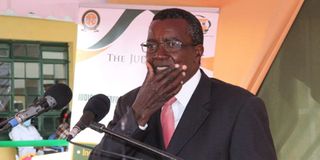The way Kenya dies is how it lives

Chief Justice David Maraga.
What you need to know:
- The 2010 Constitution provides that no elected and appointed body should have more than two-thirds representation from one gender.
- If this had happened five years ago, President Kenyatta might have spoken 24 hours later.
- But in his second-term fashion, he kept his powder dry and is likely to let the issue wither on the vine.
There was a lot of excitement on Monday in Kenya. My heart skipped a bit early that day with the flurry of social media and message notifications.
Chief Justice David Maraga had thrown a cat amongst the pigeons with his letter to President Kenyatta recommending that he dissolve Parliament over the failure of MPs to pass legislation on the two-thirds gender rule, 10 years after they were supposed to. The 2010 Constitution provides that no elected and appointed body should have more than two-thirds representation from one gender.
If you have lived in a country which has had coups, the reception Maraga’s letter received was the type you get when a young flight lieutenant clears his throat to make an announcement after the army has seized state TV and radio.
By Tuesday evening, though, the story was beginning to peter out. If this had happened five years ago, President Kenyatta might have spoken 24 hours later. But in his second-term fashion, he kept his powder dry and is likely to let the issue wither on the vine. He was at the coast, in cap and khakis, inspecting projects — and we saw photographs of him staring out into the distance of the Indian Ocean.
However, both events were quite politically meaty. What is striking about today is how restless the Kenyan spirit, and how agitated the people, are. In recent weeks, a massive wave of anger swept the land after NTV’s “Covid-19 Billionaires” report on the alleged looting of coronavirus money and supplies. There were a couple of smaller political skirmishes in-between, until the shocking and extremely unsettling video of a woman in labour on the street outside Nairobi’s Pumwani Hospital, having allegedly been turned away.
Letter resonated
Against this backdrop, Maraga’s letter resonated because it seemed like an antidote. There’s something else in the agitated public mood in Kenya. While a lot of it is targeted at the ruling Jubilee, the political class, and is programmatic — focused on failures by the government on specific issues like corruption — what’s striking is how much it also critiques “this thing Kenya”. This at a time when there are no fresh bleeding wounds of a disputed election. It’s the most I have sensed this level of questioning of the Kenyan state itself in over 10 years.
But Kenya being Kenya, the story doesn’t end there. That’s only the middle of it. The Constitution, which created the gender rule that CJ Maraga writes of, also established the counties.
Perhaps the most consequential debate through all these dramas was happening in the Senate over revenue allocation to the counties. It was emotional and impassioned, but was also a show of clever and impressive statecraft. The revenue formula was, at the end of the day, about the distribution of pieces of Kenya. And after angry shows, arrests of alleged ethnic-merchandising senators, and threats of secession, the senators came up with an innovative formula.
It was like watching a jazz piece being born. After the players have improvised in all different directions, the song came together. Thus, amid the scary dysfunction, and even fragility, we saw a near-equal evidence of an adaptive and resilient system.
Which leaves the question, what is President Kenyatta’s game in all this? He’s doing a Kibaki, in the fashion of his predecessor, President Mwai Kibaki, who rarely got visibly into the boxing ring and looked better in the end because he was one of the few who didn’t have blood on the front of his shirt.
Less-publicly combative
President Kenyatta has suddenly morphed into a less-publicly combative politician but, obviously, he has only worn gloves over his knuckles. Mostly working through surrogates, he purged Jubilee Party, and the leaderships of Parliament, the Senate and their committees of Deputy President William Ruto’s entourage as their political bromance continues to sour in the 2022 succession tug-of-war.
While he took a bureaucratic position on the revenue-sharing formula, the President decided he wouldn’t die on that hill, leaving the Senate to battle over it, and let the glory go to the senators, who are priming themselves for greater things in the times to come. He wrestled Nairobi out of the hands of Governor Mike Sonko, created the Nairobi Metropolitan Services and handed it to air force Major-General Mohamed Abdalla Badi to run. These days, one sees a lot of praises about how Badi and the NMS have transformed the city.
Outspoken politicians in his “backyard” (to use the loaded expression), like MP Moses Kuria, who were a thorn in his side, seem to have gone on a sabbatical. There is the harder battle still not won: To create that quintessentially Kenyan creature, the election season villain. DP Ruto was nearly boxed into that corner, but he’s still proving to be slippery.
Which takes us back to the CJ’s letter. If Kenya functions through this kind of deadly push and pull, the surprise, then, could be that it took him this long to write it.
Mr Onyango-Obbo is a journalist, writer and curator of the Wall of Great Africans. @cobbo3





